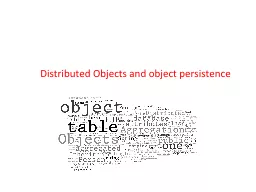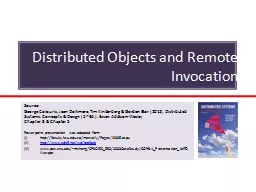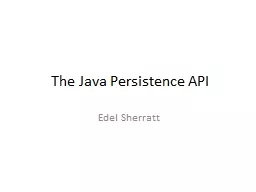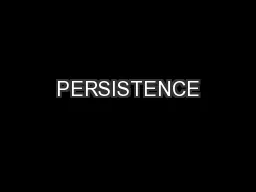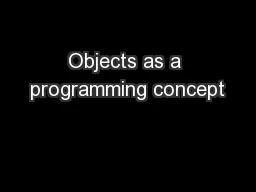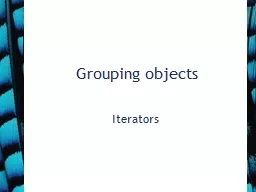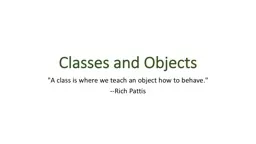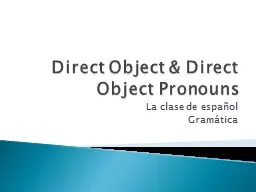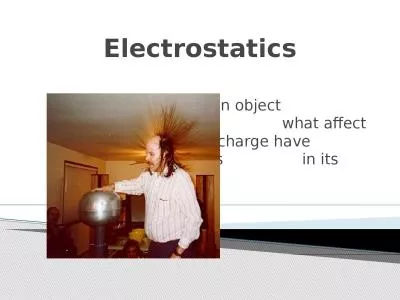PPT-Distributed Objects and object persistence
Author : yoshiko-marsland | Published Date : 2019-03-14
2 Distributed objects Distributed computing part of the system located on separate computers Distributed objects allow objects running on one machine to be used
Presentation Embed Code
Download Presentation
Download Presentation The PPT/PDF document "Distributed Objects and object persisten..." is the property of its rightful owner. Permission is granted to download and print the materials on this website for personal, non-commercial use only, and to display it on your personal computer provided you do not modify the materials and that you retain all copyright notices contained in the materials. By downloading content from our website, you accept the terms of this agreement.
Distributed Objects and object persistence: Transcript
2 Distributed objects Distributed computing part of the system located on separate computers Distributed objects allow objects running on one machine to be used by client applications on different computers. Domain Model. James Kovacs. JamesKovacs.com. jkovacs@post.harvard.edu. POCO – Plain Old CLR Object. No persistence-related code. Only business logic. public class Customer {. public string Name { get; } . Objects and Remote Invocation. Source:. George . Colouris. , Jean . Dollimore. , Tim . Kinderberg. & Gordon Blair (2012). Distributed Systems: Concepts & Design (5. th. Ed.). Essex: . Addison-Wesley. Edel Sherratt. Contents. Revisit applications programming. Using Java Persistence API. Applications Programming Alternatives. Extend a high level language by embedding SQL statements in it. Extend SQL with programming language constructs. Distributed Objects (Background). The . message-passing . paradigm is a natural model for distributed computing, in the sense that it mimics inter-human communications. It is an appropriate paradigm for network services where processes interact with each other through the exchanges of messages. . Robert Reichardt. October 12, 2012. Admissions and Transfer Group. Department of Higher Education, Denver CO. Overview. Background, sample and limitations. CSAP Analysis. Does . the CSAP predict whether a student will attend a 4-year or 2-year institution?. AND . PERSEVERANCE. Daughter of FAITH. is to continue whatever you want to do . inspite. difficulties. PERSISTENCE. . is undertaking a task . inspite. laborious, wearisome, demanding and burdensome situations. Direct & Indirect Objects. Direct & Indirect Objects can happen when your sentence has an ACTION verb:. Jump. Skip. Cook. Yell. smile. Subject Compliments. Subject Compliments happen when your sentence has a LINKING verb.. Topic D.1.2. Distinguish between an . object. . (definition, template or class) and . instantiation. Class vs. Object. Reminder: Steps in object creation. A . class provides the . blueprints. for objects. . Iterator. and . iterator(). Collections have an . iterator(). method.. This returns an . Iterator. object.. Iterator<E>. has three methods:. boolean hasNext(). E next(). void remove(). Using an Iterator object. Development of a DSS. Ben Letcher. USGS, Conte Anadromous Fish Research Center, Turners Falls, MA. . Keith Nislow. USFS, Northern Research Station, Amherst, MA. Why care about brook trout?. Widespread. --Rich Pattis. C Classes. Classes are programmer-defined types. Classes help us manage complexity, since they:. tie together related data and operations. decompose an application into objects and their interactions. La . clase. de . español. Gramática. ________________ take the place of nouns. . They have different forms depending on how they are being used in a sentence. . Modelo. : Ana . es. mi . amgia. . . threaded. Active . Objects. : Design and . Implementation. Justine Rochas. Thesis. . supervised. by Ludovic . Henrio. (CNRS). Reviewers. . Einar. . Broch . Johnsen. . University. . of Oslo. What makes up all matter?. What does it mean to be “charged”?. What are the (names &) methods of charging?. What do charged objects do?. What is GROUNDING?. What . are insulators & conductors?.
Download Document
Here is the link to download the presentation.
"Distributed Objects and object persistence"The content belongs to its owner. You may download and print it for personal use, without modification, and keep all copyright notices. By downloading, you agree to these terms.
Related Documents

